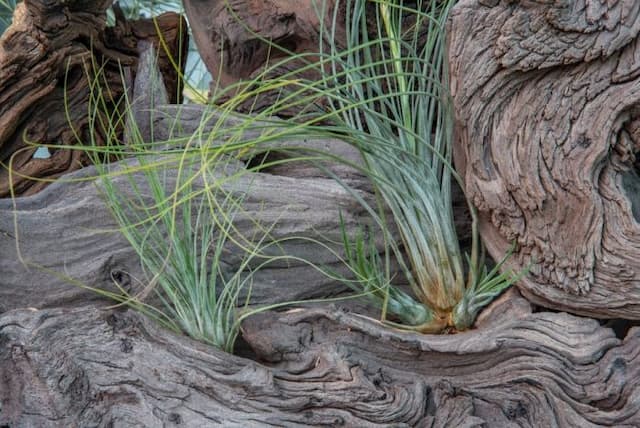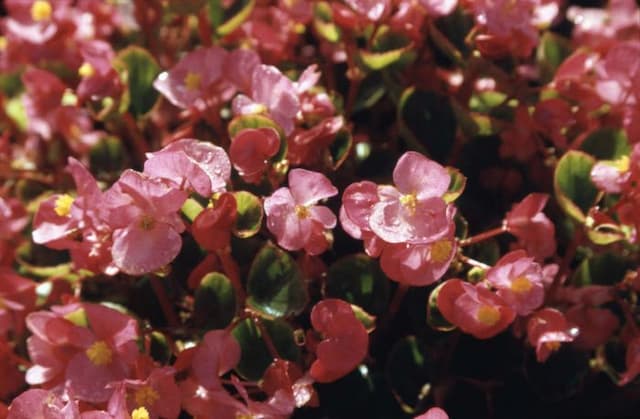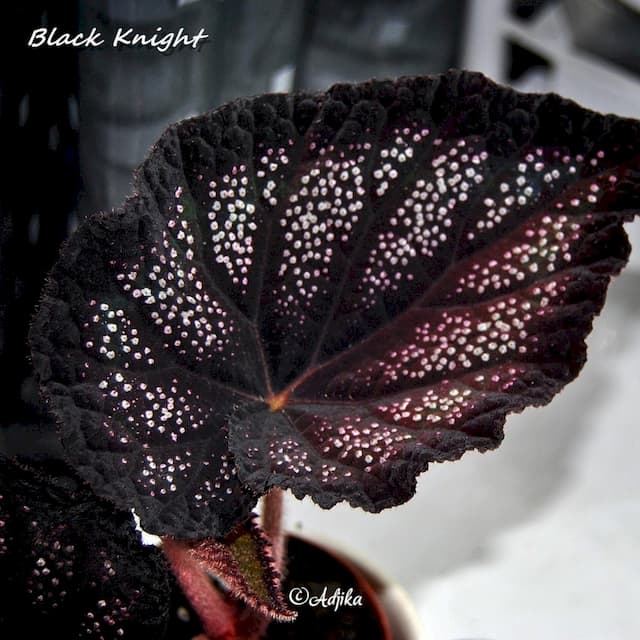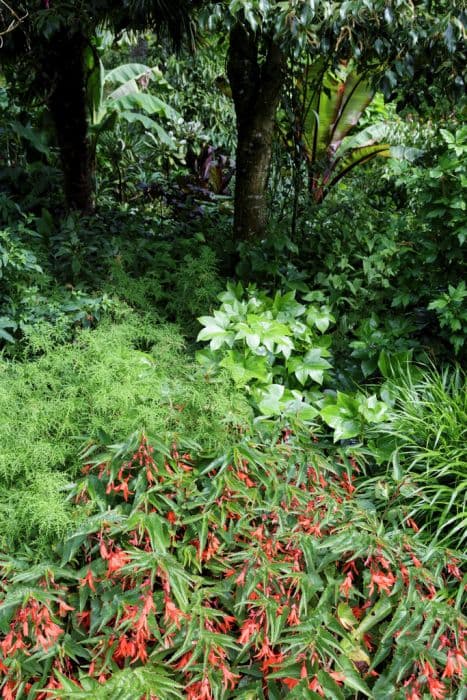Wax Begonia Begonia 'Sal's Comet' (R)

ABOUT
Begonia 'Sal's Comet' is a vibrant and ornamental plant known for its striking visual appeal. Its foliage is lush, showcasing a blend of colors including shades of green, red, and bronze, while the leaf surface may exhibit a unique, metallic sheen that catches the light. The leaves themselves are broad and can display an asymmetrical, heart or wing-like shape, often with intricate edges that may be toothed or wavy. The textures of the leaves vary, sometimes being smooth to the touch, while other times feeling like delicate velvet. During its blooming period, Begonia 'Sal's Comet' reveals clusters of flowers that contrast or complement the foliage. The flowers possess a certain delicate charm, with petals that may be either smooth or ruffled, and they come in a variety of colors from white to pink or red, often with a multitude of flowers per cluster. The plant as a whole has a bushy, full appearance, creating a sense of lushness and abundance that makes it a popular choice for gardeners and plant enthusiasts.
About this plant
 Names
NamesFamily
Begoniaceae
Synonyms
Sal's Comet Begonia
Common names
Begonia 'Sal's Comet'
 Toxicity
ToxicityTo humans
Begonias, including 'Sal's Comet', contain compounds such as oxalate crystals that can be irritating when ingested. If any part of a begonia is eaten by a human, it can cause symptoms such as a burning sensation in the mouth, throat, and lips, as well as difficulty swallowing, nausea, vomiting, and salivation.
To pets
Begonias, including 'Sal's Comet', are also toxic to pets due to oxalate crystals. Ingestion can lead to similar symptoms as in humans, including irritation of the mouth and gastrointestinal tract, drooling, vomiting, and difficulty in swallowing. Pets might also exhibit signs such as pawing at the face or mouth due to irritation.
 Characteristics
CharacteristicsLife cycle
Perennials
Foliage type
Evergreen
Color of leaves
Mixed
Flower color
Pink
Height
1-1.5 feet (30-45 cm)
Spread
1-1.5 feet (30-45 cm)
Plant type
Herb
Hardiness zones
10
Native area
Central America
Benefits
 General Benefits
General Benefits- Ornamental Appeal: Begonias are known for their attractive foliage and flowers, adding aesthetic value to indoor and outdoor spaces.
- Variety of Colors: They come in various colors which can brighten up any garden or home with their vibrant hues.
- Shade Tolerance: Begonias generally do well in shaded areas where other flowering plants might not thrive, increasing the diversity of planting options.
- Easy to Care for: They are relatively low maintenance, requiring minimal care to keep them looking their best.
- Long Blooming Season: Many begonias bloom throughout the summer, providing continuous color and interest.
- Versatility: They can be used in a variety of garden designs, from beds and borders to containers and hanging baskets.
- Propagation Ease: Begonias can be easily propagated from cuttings, allowing gardeners to create more plants for free.
 Medical Properties
Medical PropertiesThis plant is not used for medical purposes.
 Air-purifying Qualities
Air-purifying QualitiesThis plant is not specifically known for air purifying qualities.
 Other Uses
Other Uses- Artistic Inspiration: Begonias, with their vibrant colors and unique patterns, can serve as a muse for artists, offering a rich subject for paintings, drawings, or textile designs.
- Edible Decor: While not a common practice, the petals of some Begonia varieties are edible and can be used to add a splash of color to salads or as a decorative garnish on desserts and drinks.
- Photography Subjects: With their diverse and striking appearances, Begonia flowers can be excellent subjects for photographers looking to capture the intricate details of nature.
- Education & Research: Horticulture students or researchers can study Begonia 'Sal's Comet' as a model for understanding hybridization, genetics, and plant breeding techniques.
- Crafting: Dried Begonia petals can be incorporated into crafting projects, such as making homemade paper or pressed flower arrangements.
- Floral Language & Symbolism: Begonias are often associated with caution or a fanciful nature, making them an interesting addition to bouquets that are meant to send a specific message.
- Natural Insect Deterrent: Some Begonia species are known to repel certain insects, so placing them around the patio or garden may help reduce the presence of these pests.
- Container Gardening Education: Perfect for beginners, Begonias can be used to teach the basics of container gardening and plant care.
- Psychological Benefits: Caring for plants such as Begonias can offer psychological benefits by reducing stress and promoting a sense of well-being through the act of nurturing living things.
- Seasonal Decor: Begonia 'Sal's Comet' can be integrated into seasonal decor arrangements, providing a fresh and lively accent for holiday decorations, especially during spring and summer.
Interesting Facts
 Feng Shui
Feng ShuiThe Begonia is not used in Feng Shui practice.
 Zodiac Sign Compitability
Zodiac Sign CompitabilityThe Begonia is not used in astrology practice.
 Plant Symbolism
Plant Symbolism- Caution: Begonias, in general, symbolize a message of caution. They are often given to someone as a way to say "beware" or "proceed carefully" in a certain situation.
- Gratitude: The begonia can also represent gratitude. Giving someone this plant might be a way to thank them for their help or kindness.
- Uniqueness: With its distinctive features, the Begonia 'Sal's Comet' can symbolize individuality and standing out from the crowd. This makes it a perfect gift for someone who is a true original.
- Harmony: The balance in the foliage and flowers of begonias can represent harmony and peace. It suggests a sense of tranquility in the home or relationship.
 Water
WaterThe Begonia 'Sal's Comet' prefers to be watered when the top inch of soil feels dry to the touch, typically once a week, but this can vary with environmental conditions. It's crucial not to let the plant sit in water as this can lead to root rot. When watering, use room temperature water and pour it evenly over the soil until it begins to drain out of the bottom of the pot. For an average-sized plant, this may be around 16 to 24 ounces every week. Always check the soil moisture level before watering to avoid over-watering.
 Light
LightBegonias, including 'Sal's Comet', thrive in bright, indirect light away from direct sunlight, which can scorch their leaves. A spot near a window with a sheer curtain that diffuses the light would be ideal. These plants can also tolerate fluorescent lighting, making them suitable for office environments or rooms with less natural light.
 Temperature
TemperatureBegonias like 'Sal's Comet' prefer temperatures between 60 and 70 degrees Fahrenheit to thrive. They should be protected from drafts and not exposed to temperatures below 50 degrees Fahrenheit or above 80 degrees Fahrenheit as extreme temperatures can damage the plant. The ideal range offers a comfortable room temperature for most indoor settings.
 Pruning
PruningPrune Begonia 'Sal's Comet' to maintain its shape and remove any dead or yellowing leaves. The best time for pruning is in the spring or summer when the plant is actively growing. Light pruning can be done as needed throughout the year to encourage bushiness and remove any unsightly or overgrown branches.
 Cleaning
CleaningAs needed
 Soil
SoilBegonias such as 'Sal's Comet' prefer a well-draining soil mix that can retain moisture without becoming waterlogged. A mix of peat, pine bark, and perlite in equal parts works well. The soil pH should be slightly acidic to neutral, ideally between 5.5 and 6.5.
 Repotting
Repotting'Sal's Comet' begonia should be repotted every 1-2 years, or when you notice the roots have filled the current pot. Spring or summer is the best time to repot to minimize stress on the plant.
 Humidity & Misting
Humidity & Misting'Sal's Comet' begonia thrives best in high humidity levels, ranging from 50% to 70%. If the indoor air is dry, consider using a pebble tray with water or a humidifier to maintain the ideal humidity around the plant.
 Suitable locations
Suitable locationsIndoor
Place in bright, indirect light and keep soil mildly moist.
Outdoor
Provide shade, protect from winds, and ensure soil drains well.
Hardiness zone
10-11 USDA
 Life cycle
Life cycleBegonia 'Sal's Comet' begins its life cycle as a seed. Upon germination, it enters the seedling stage where it develops its first set of true leaves. As it matures into vegetative growth, it forms a bushy plant with large, ornamental leaves. During the blooming stage, Begonia 'Sal's Comet' produces clusters of vibrant, comet-like flowers. After pollination, if successful, it sets seed for the next generation. Eventually, the plant will reach the end of its lifecycle and die back, primarily if it experiences colder temperatures or conditions outside of its preferred environment.
 Propogation
PropogationPropogation time
Spring to Summer
The Begonia 'Sal's Comet' is best propagated through leaf cuttings, which is the most popular method for this type of plant. This process typically begins in the spring or early summer when the plant is actively growing. The propagation by leaf cuttings involves selecting a healthy and mature leaf from the plant, cutting it into sections with a sterilized and sharp knife, ensuring that each section has at least one vein. These cut sections are then placed in a moist potting mix, ensuring the vein touches the soil, and are often covered with plastic to maintain humidity. It is important to keep the leaf cuttings warm, around 70°F (about 21°C), and in indirect sunlight. Roots will usually develop in a few weeks, after which they can be potted as individual plants.

![Begonia [Allure]](/_next/image?url=https%3A%2F%2Fplants-admin.emdemapps.com%2Fimages%2Fplants%2F%2Fimages%2F604b5b9006ab9.png&w=640&q=75)







